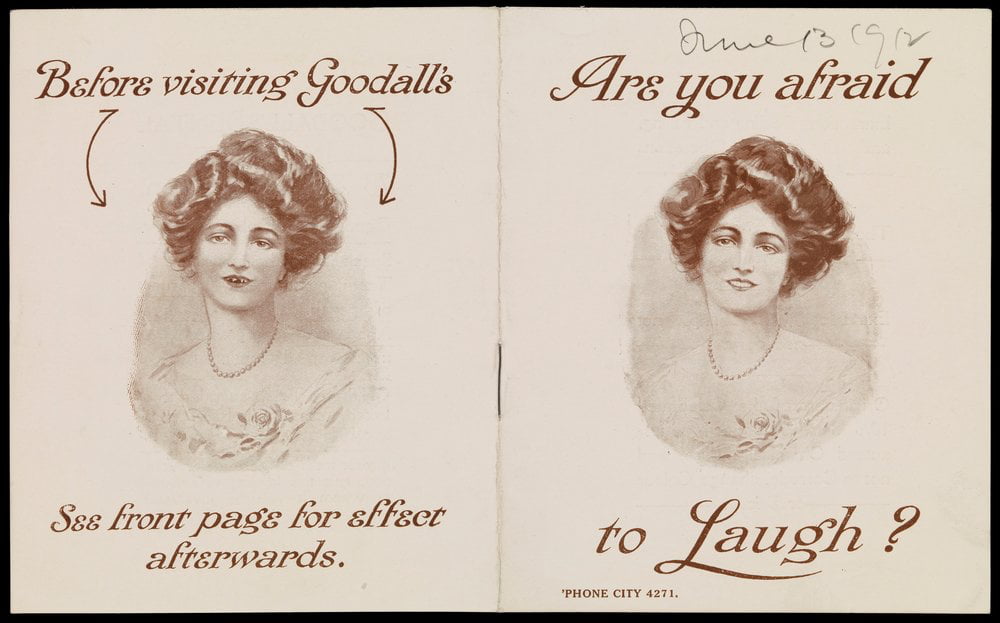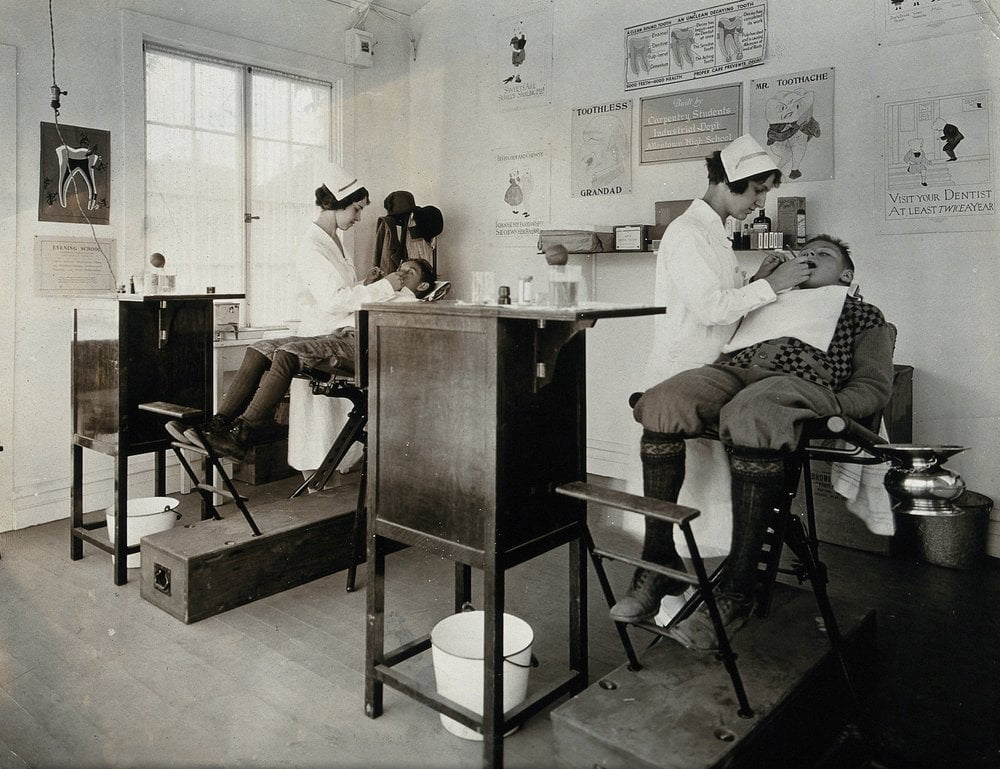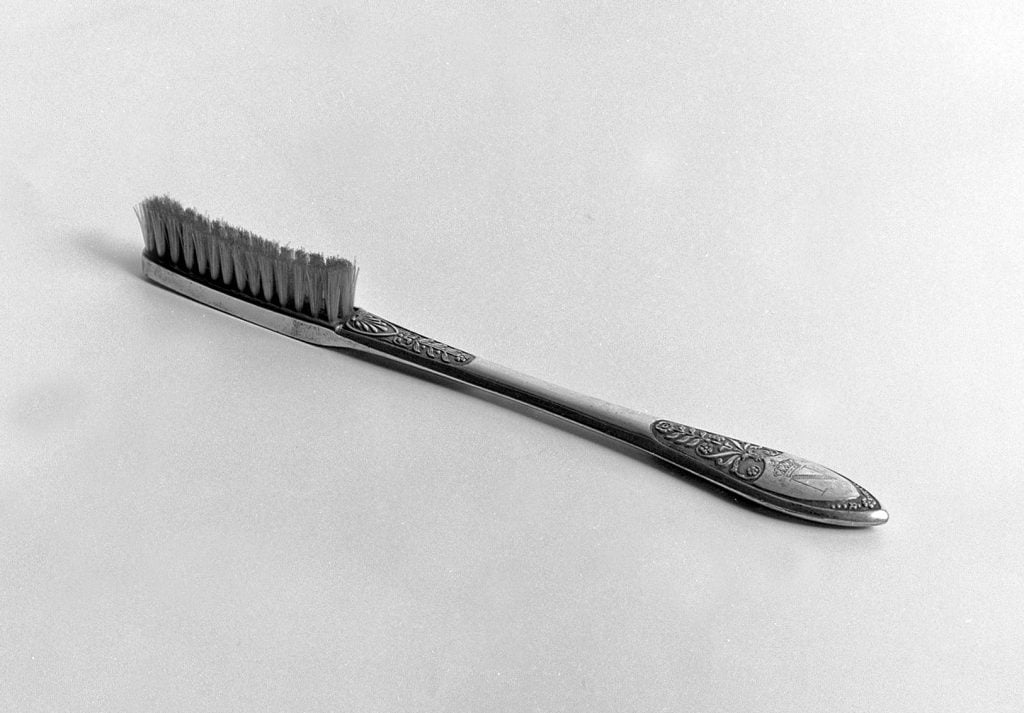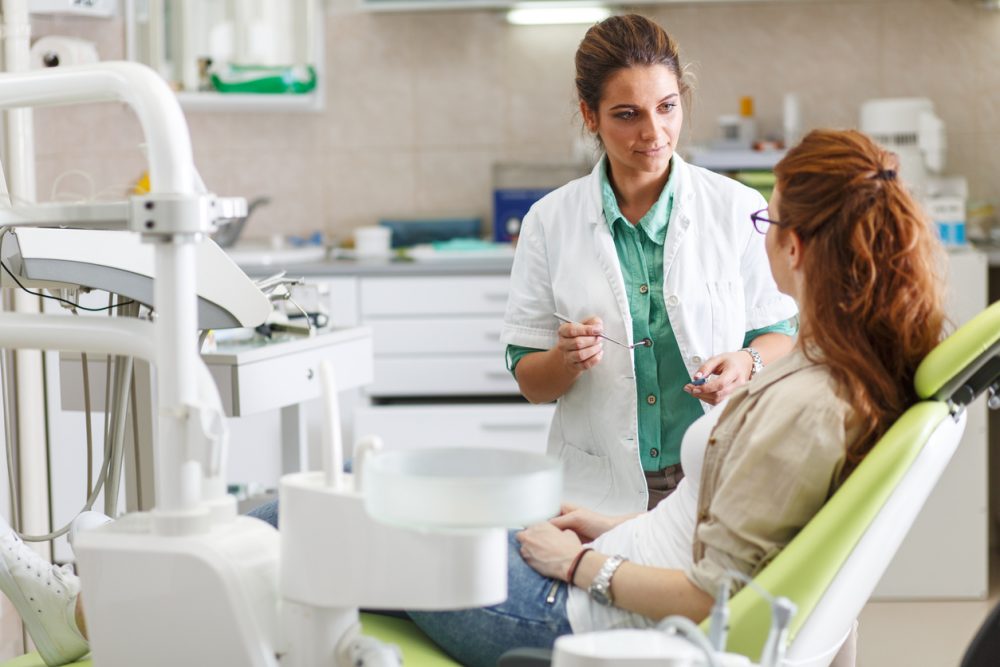In this blog for our Evidence for Everyday Health Choices series, Sarah Chapman looks at the Cochrane evidenceCochrane Reviews are systematic reviews. In systematic reviews we search for and summarize studies that answer a specific research question (e.g. is paracetamol effective and safe for treating back pain?). The studies are identified, assessed, and summarized by using a systematic and predefined approach. They inform recommendations for healthcare and research. for aspects of routine dental care. Something to smile about? Or are there big gaps…?

Wellcome Collection.
My grandmother used to tell the tale of when she was a schoolgirl, back in about 1920, and a school event to which parents were invited. Nan and her friend enjoyed a carefree afternoon without their mothers there, having avoided inviting them – the friend because her mother had white hair, and Nan because her mother had just had all her teeth taken out. There was trouble, she recalled, when they were rumbled by a write-up of the event.
Teenagers haven’t changed much in the hundred years since then, but thankfully the state of the nation’s teeth has. My great-grandmother would not have been unusual in having all her teeth removed, to be replaced by an easier-to-care-for set of dentures, and some women even received this as a 21st birthday present! This changed, thanks, in part, to free dental treatmentSomething done with the aim of improving health or relieving suffering. For example, medicines, surgery, psychological and physical therapies, diet and exercise changes. through the NHS from its beginning in 1948, the fluoridation of toothpaste from 1959, improvements in diet and a new emphasis on good dental hygiene.
Today, we are commonly told we should have a dental check-up every six months, and a visit to the dental surgery often includes getting advice from a hygienist on how to care for our teeth and gums, and perhaps a ‘scale and polish’. This routine dental care is all so familiar we may not question it, but we should! What’s the evidence? Does it give us, and our dental health professionals, something to smile about?
How often should you have a dental check-up?
As a child, I loved my regular visits to the dentist. As an infant, I delighted in the toy farm in the waiting room with, joy of joys, a ‘real’ well with a bucket you could wind up; while my teenage dental trips were always followed by a visit to the ice cream parlour (oh dear…)! But is there any evidence behind the common recommendation that we should go every six months?
An update to the Cochrane ReviewCochrane Reviews are systematic reviews. In systematic reviews we search for and summarize studies that answer a specific research question (e.g. is paracetamol effective and safe for treating back pain?). The studies are identified, assessed, and summarized by using a systematic and predefined approach. They inform recommendations for healthcare and research. on recall intervals for oral health in primary care patients in October 2020 has changed matters since I wrote this blog, when the effects of different periods of time between check-ups was uncertain. There is now high-certaintyThe certainty (or quality) of evidence is the extent to which we can be confident that what the research tells us about a particular treatment effect is likely to be accurate. Concerns about factors such as bias can reduce the certainty of the evidence. Evidence may be of high certainty; moderate certainty; low certainty or very-low certainty. Cochrane has adopted the GRADE approach (Grading of Recommendations Assessment, Development and Evaluation) for assessing certainty (or quality) of evidence. Find out more here: https://training.cochrane.org/grade-approach evidence that there is little or no evidence of a difference between six-monthly check-ups and those based on individual riskA way of expressing the chance of an event taking place, expressed as the number of events divided by the total number of observations or people. It can be stated as ‘the chance of falling were one in four’ (1/4 = 25%). This measure is good no matter the incidence of events i.e. common or infrequent. in terms of tooth decay (number of tooth surfaces affected), gum disease and quality of life after four years. There is probably little to no difference in how many people had moderate‐to‐extensive tooth decay.
Comparing 24‐monthly and six‐monthly or risk‐based check‐ups, there is probably little to no difference between them in tooth decay (number of people and number of tooth surfaces affected), gum disease or well‑being, and may be little to no difference in how many people had moderate‐to‐extensive tooth decay.
The evidence on recall intervals for children and adolescents remains uncertain.
Possible harms of different recall intervals were not assessed in the two studies in the review.
You can read more about the review in this blog Dental check-ups: how often is enough?
Oral hygiene advice
A newly published Cochrane Review aimed to address uncertainties about the impact of one-to-one oral hygiene advice (OHA), given by a dental care professional in a dental setting, on our oral health, attitudes and behaviour, by bringing together the best available evidence. Although the review includes 19 studies (randomisedRandomization is the process of randomly dividing into groups the people taking part in a trial. One group (the intervention group) will be given the intervention being tested (for example a drug, surgery, or exercise) and compared with a group which does not receive the intervention (the control group). trialsClinical trials are research studies involving people who use healthcare services. They often compare a new or different treatment with the best treatment currently available. This is to test whether the new or different treatment is safe, effective and any better than what is currently used. No matter how promising a new treatment may appear during tests in a laboratory, it must go through clinical trials before its benefits and risks can really be known.) with over 4000 people, there was so much variation that the team weren’t able to pool the dataData is the information collected through research., and concluded that “there was insufficient high‐quality evidence to recommend any specific one‐to‐one OHA method as being effective in improving oral health or being more effective than any other method.”
That’s disappointing. So what about that ‘scale and polish’? Is the evidence any better?
Routine scale and polish

Both hygienists and dentists provide scaling and polishing for their patients at regular intervals, even when those patients are at low risk of gum disease. There is uncertainty about whether this is useful and how often it should be done. Along with a sit-down and a chance to reflect on your guilt about not having flossed when you were told to, the ‘routine scale and polish’ offers you the removal of deposits of bacteria called plaque, and hardened plaque known as tartar or calculus, which is too hard for removal by toothbrushing by even the most diligent brushers (I’m looking at my husband, bafflingly motivated by the promise of a digital smiley face after two minutes, on a gadget linked to his toothbrush. He is 55…).
A Cochrane Review on routine scale and polish has just been updated and at last we have some robust evidence to inform practice. There is now high-certainty evidence that for healthy adults without severe gum disease, who regularly access routine dental care, routine scale and polish treatment makes little or no difference to early signs of gum disease over two to three years follow‐up, compared with having no scheduled scale and polish treatments. There is a small reduction in calculus (tartar) but its importance is uncertain, and there may be little or no difference in plaque levels. People having six- or twelve-monthly scale and polish reported feeling their teeth were cleaner than those who didn’t have it, but there did not seem to be a difference between groups in oral health-related quality of life. The studies didn’t look at adverse effects.
Flossing?
I have yet to meet a dental hygienist who didn’t advocate flossing, but I really can’t be bothered to do it, and I don’t want to find a reason to add yet another source of plastic to my environmental footprint. Need I feel guilty? There’s a Cochrane Review on flossing too, which includes 12 studies with 582 people, comparing flossing and toothbrushing with toothbrushing alone. All the studies looked at the effects on gum disease and plaque. Once again, there was so much variation between the studies that the data couldn’t be pooled. Whilst there is some evidence that flossing added to toothbrushing may reduce gum disease and plaque compared to just toothbrushing, it is unreliable. For adults, feel free to choose whether or not to floss your teeth, but it’s probably wise to steer clear of this year’s dance trend, or you risk being ridiculed for your flossing, like Jeremy Corbyn at the Pride of Britain Awards.
Check your bathroom shelf

Finally, while good evidence on these elements of routine dental care is lacking, there is evidence to guide us on what we have at home, in those basics of toothbrushes and toothpaste. Something to smile about! A Cochrane Review found moderate-certainty evidence that powered toothbrushes probably reduce plaque compared with manual toothbrushes, in the short- and long-term. (If trialists want to explore the impact of a digital smiley face toothbrushing interventionA treatment, procedure or programme of health care that has the potential to change the course of events of a healthcare condition. Examples include a drug, surgery, exercise or counselling. , I will volunteer my husband.)
Another Cochrane Review found that fluoride toothpaste containing triclosan and copolymer leads to a small reduction in tooth decay and is probably more effective at reducing plaque and gingivitis than fluoride toothpaste without those ingredients. However, as of early 2019 toothpaste containing triclosan is no longer commercially available, so the review will no longer be updated. It will be replaced by a review on antibacterial toothpastes, which the authors hope to publish in 2023. As for chlorhexidine mouthwash, you can read all about the Cochrane evidence in this blog by dentist Bosun Hong.
Join in the conversation on Twitter with @SarahChapman30 @CochraneUK @CochraneOHG or leave a comment on the blog. Please note, we will not publish comments that link to commercial sites or appear to endorse commercial products.
Sarah Chapman has nothing to disclose.
Page last updated 26 July 2021.



In order to treat her orthodontic concerns, my niece is going to put on braces, therefore she will require routine checkups and modifications. My sister is searching for a reputable and skilled orthodontist to make sure her oral health is taken care of. They ought to be aware, too, that although there isn’t much solid data supporting these aspects of regular dental care, there is data supporting the use of common household items like toothpaste and toothbrushes.
A very good oral hygiene is necessary to keep teeth and gums healthy. It involves habits such as brushing twice a day and having regular dental checkups.
Brushing thrice a day after each meal can be the easiest and simplest way to care for your dental health. In addition, you must employ toothbrush and toothpaste that are of good quality. However, you need to be careful while brushing the teeth and avoid being too hard as it can cause tooth abrasion and damage.
I too enjoyed reading this and am very glad I did not live 100 years ago! Would be great to see more studies which would help us to determine if the investment is worth it. Referring to personal financial investment: in the UK you have the NHS so a dental visit or cleaning costs very little compared to what we have to pay in other countries.
Enjoyed reading this summary about the evidence behind dental routine care! A couple of studies we ran / are running at the Health Services Research Unit (@hsru_aberdeen) might be of interest: a 3-year randomised controlled trial (RCT), IQuaD, that helped answer the question: does 6-monthly scale & polish improve oral health (ie bleeding gums, calculus, pocket depth) compared with no scale and polish or 12-mo scale and polish? We also tested personalised vs routine oral hygiene advice in IQuaD. Results are available here: http://bit.ly/2zx1WbX . We are currently writing the monograph for a large RCT on dental check-ups. The protocol has been published here: https://bmcoralhealth.biomedcentral.com/articles/10.1186/s12903-018-0587-2
It’s really interesting to see this – thank you for sharing it.
Sarah Chapman [Editor]
I’ve now referred to the IQUaD trial in the main text of the blog – thank you. It would be great to have a blog from you, if you’re interested?
Sarah
Thank you Sarah! I would be keen to contribute of course, but I am not sure how to do it?